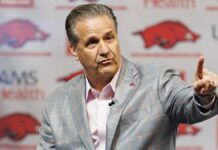The Formula One season starts with the Bahrain Grand Prix on March 28.
While not much has changed on the surface, with Covid pushing back the big aerodynamic rule change from this year to 2022, there is plenty at stake this season. For one thing, preseason testing has hinted at the closest championship fight in recent memory.
Every team has something big riding on this year. In championship order from last year, we run through the most pressing concern facing each team going into the new campaign.
Mercedes
Avoiding the end of an era
Mercedes’ domination of Formula One is starting to look under threat. We’re not talking about the team’s lack of performance during preseason testing — although it didn’t help — but instead what lies beyond 2021 and how committed certain aspects of the team appear to be.
First and foremost, Lewis Hamilton’s decision to limit his latest contract to a single year was a genuine surprise earlier this year. The expectation was for a two-year deal at the very least, and although there were factors at play that rushed the talks, such as the COVID pandemic and delaying a sit down with team boss Toto Wolff until after the championship was won, it seems like there is more to the story.
If Hamilton decides to walk away at the end of the year, Mercedes will lose a key component of its period of dominance in F1 and its most valuable marketing asset. That’s not to say the team can’t win titles without him, but such periods of dominance in the sport are almost always tied to a driver — think Ayrton Senna at McLaren, Michael Schumacher at Ferrari and Sebastian Vettel at Red Bull — and when things start to crumble, the driver often leaves soon after or just before.
On the plus side, Wolff himself has committed to three more years with the team, albeit under a restructured ownership model that sees the company split three ways with Mercedes’ parent company Daimler, chemical giant Ineos and Wolff himself. Mercedes has made clear it is still committed to F1, but its reduction in its shareholding and its desire for the outfit to turn a profit rather than be a cost centre signifies a change in thinking from Germany.
On top of all of that, new sets of technical and financial regulations for 2022 have been drafted with the objective of preventing a single team from dominating the sport. That alone would make it hard to keep the Mercedes juggernaut in motion, but combined with what appears to be a less competitive car in 2021 and doubts over the future of its star driver, the world champions face their biggest challenge yet to focus their resources on overall victory.
Red Bull
Beating Mercedes over 23 races
It’s one thing to build the fastest race car on the grid, it’s another to secure a championship with it. Just ask Ferrari about its experience in 2018 and how distant both drivers’ and constructors’ titles were by the end of the season.
On the basis of testing, Red Bull looks like it will be a match for Mercedes this year, which is a year earlier than most people expected. Even if Mercedes recovers from its poor form in testing (and it almost certainly will), Red Bull has made a significant step forward over the winter and looks set to challenge the world champions for victories on merit.
If that’s the case, it will turn Red Bull’s usual race tactics on their head. Last year the team regularly rolled the dice on strategy, knowing it will likely be its only chance to beat Mercedes (and knowing the rest of the field is so far back there were very few consequences of taking a gamble). But when you are the team being hunted, the mindset needs to change and the percentages need to be played.
In Max Verstappen, Red Bull undoubtedly has a driver capable of getting the most out of the car in terms of performance, but we have yet to see him under pressure in a championship fight. If he finds himself in a battle for the title this year, it is likely to be with a man who has won it seven times before, so Verstappen will have to retain a cool head at crucial moments.
That’s not to say Red Bull isn’t ready to a win a title, but against rivals like Mercedes it can’t afford to make any mistakes.
McLaren
Living up to Ricciardo’s championship billing
Daniel Ricciardo joined McLaren to win a world championship. That might seem a tall order given the team’s recent past but there’s a rule change on the horizon and the team has switched to Mercedes power this season, so there are plenty of reasons to be positive.
Team boss Andreas Seidl has been a revelation since taking control of the day-to-day operations and there has been a clear upward trajectory in recent seasons. Ricciardo’s arrival vindicated that progress – the Australian driver did not feel McLaren was in the right place when they offered him a contract just two years earlier.
Ricciardo is also the perfect person to continue that forward momentum, having forged a reputation as the grid’s best overtaker and making a habit of snatching big results whenever they have presented themselves since his breakout season in 2014. Those opportunities will be on offer for McLaren this year.
This will also be a big year for Lando Norris. While there is still a question-mark over just how good previous teammate Carlos Sainz is, Norris now has a benchmark who boasts multiple race victories and genuine world championship pedigree. That could go one of two ways for Norris — expose flaws or emphasise his talent — but it would leave McLaren in no doubt about his potential going into a key season in 2022.
Aston Martin
Live up to the hype
Team owner Lawrence Stroll has invested big in the team formerly known as Racing Point. He’s signed four-time world champion Sebastian Vettel — teammate to Lawrence’s son Lance — to lead the rebrand of one of the most iconic car manufacturers in the world.
Stroll hasn’t shied away from setting lofty expectations for the team. So often the Silverstone outfit was ‘the little team that could’ but Stroll wants to turn it into a bonafide championship contender. That won’t happen in 2021 but the performance of the team will be under scrutiny from the very first race.
Last year Racing Point’s car — dubbed ‘the pink Mercedes’ — was controversial but Sergio Perez signed off the pre-Aston era with a victory at the Sakhir Grand Prix. The scale of the achievement for the team may have flown under the radar slightly given the excitement generated by Perez’s first F1 win, but it was a huge moment.
The arrival of Vettel and the big-money rebrand means there are no excuses for not continuing that upward trajectory. Claiming a victory on outright pace in 2021 is unlikely but at the very least this team needs to cement itself as the best team in the midfield going into such a big year in 2022, which presents a huge opportunity in terms of resetting the pecking order.
Alpine
Keeping Alonso’s expectations in check
There have been major changes at Alpine over the winter beyond the new name and new livery.
The most obvious one is the departure of Daniel Ricciardo and the arrival of Fernando Alonso, but the management structure has also been overhauled, with former team boss Cyril Abiteboul leaving the outfit.
The management is now headed up by new Alpine CEO Laurent Rossi, although he will not play a major role in the day-to-day running of the team. That responsibility falls on highly-rated engineer Marcin Budkowski, who joined Renault in 2018 from the FIA and has been key to the progress made in recent years.
Rather confusingly, Suzuki’s former MotoGP boss, Davide Brivio, has also joined Alpine as Racing Director, but his role will be more of trackside job while Budkowski oversees the overall direction of the team and represents Alpine at F1’s top table.
But with F1’s most demanding driver now at the team, the new management structure won’t have much time to bed in. Alonso is known for his natural speed and talent, but also his high expectations. At his two most recent teams — McLaren and Ferrari — the lack of results took their strain on the relationship between driver and team, and neither partnership ended with the success it had the potential to achieve.
In an ideal world, Alpine will produce a car capable of matching Alonso’s talent, but the reality is likely to be slow progress over the coming years and potentially very little movement up the grid this year. It will be fascinating to see how it pans out.
Ferrari
Keeping focus on 2022
A second year of struggling toward the back of midfield would be unthinkable for Ferrari, but one thing that would be significantly worse would be missing the opportunity to make up ground under next year’s regulation changes.
From its starting point in 2021, it’s very unlikely Ferrari will challenge for the title this year, but the building blocks must be put in place for 2022. The team was clear on that last year, but those statements were made before Louis Camilleri stepped down as CEO.
Camilleri was a strong supporter of team principal Mattia Binotto, who now looks more exposed without him and could become vulnerable if results continue to spiral downwards in 2021. But it’s important for Ferrari’s long-term future that the focus remains on making a bigger step in 2022, when it’s not unrealistic to start talking about championship challenges again.
A key element to success in 2021 and 2022 will be rediscovering the engine performance that went missing in 2020. The good news from testing is that a step appears to have been made and the car is no longer lacking in straight-line speed.
There’s an awful lot more to do to return Ferrari to where it should be, but it seems like F1’s most famous team is on the right track.
AlphaTauri
Steppingout of Red Bull’s shadow
This has been a long running theme for AlphaTauri, but it seems more relevant than ever. Pierre Gasly’s victory at last year’s Italian Grand Prix was one of the highlights of 2020’s F1 season and, while based on a set of circumstances unlikely to be repeated too often, showed the Faenza team is capable of standing on its own two feet.
Red Bull and AlphaTauri often resist the ‘B-team’ label when it comes up. Red Bull boss Christian Horner was quick to stress AlphaTauri is a “sister team” after Gasly’s win last year, but it’s hard to ignore the huge performance differences between them or Red Bull’s habit of using the other team to cycle through young drivers.
One of those young drivers is rookie Yuki Tsunoda, who arrives with a fair amount of hype around his rapid rise through the junior ranks. He and Gasly form a great pairing and, if AlphaTauri is a strong midfield candidate this year, there is a tantalising prospect of more podiums being up for grabs in 2021. While those kind of results would be great for AlphaTauri anyway, they would also help in strengthening the argument that its no longer just a junior team to the former world champions.
Alfa Romeo
What comes next for Sauber?
Chip away the red and white livery and peal back the logo from the team hospitality, and you’ll still find the name Sauber, not Alfa Romeo, underneath. That’s because Alfa Romeo’s return to F1 in 2018 was only ever a branding exercise and the team that first joined F1 in 1993 under then team boss Peter Sauber still exists and still runs the outfit from its base in Switzerland.
Sauber has been owned by Swiss investment firm Longbow Finance since 2016, which helped get the team back on its feet before the Alfa Romeo deal was struck with former FIAT Chrysler Automobiles boss Sergio Marchionne. That deal is up for renewal at the end of the year and it’s not clear if there is motivation within the Italian brand, which is now part of the Stellantis car group, to continue.
The loss of such a big partner would pose major questions over the future of Sauber, but with F1 gradually inching towards a more sustainable franchise model for its team owners, Longbow is still in a strong position. The incoming budget cap means the cost of competing in F1 will be slashed in coming years, and if the team can make a strong start to the 2022 regulations it will be an attractive proposition for either a new title sponsor or, if Longbow decides to leave F1, a new buyer.
Nevertheless, planning ahead in 2021 will be crucial for one of F1’s most likable midfield teams.
Haas
Treading water with two rookies
Haas is braced for a year firmly at the back of the order, but that was always expected this season. On paper, prospects for 2021 are fairly bleak.
The team arrived at preseason testing with no major upgrades for this year’s car. From what we saw over three days in Bahrain, Haas has clearly slipped behind Williams to the back of the competitive order.
But it is important to look at the bigger picture with Haas as 2021 will be a huge transitional year for the team. After years of stability with Kevin Magnussen and Romain Grosjean, the team goes into the year with rookie paring Mick Schumacher and Nikita Mazepin. The latter’s arrival comes with the financial backing of his father Dimitry’s company, Uralkali.
The arrival of that sponsorship likely played a signifiant role in team owner Gene Haas deciding to stick to his F1 commitment beyond this season. F1 is starting to resemble the kind of championship Haas has always wanted to be a part of.
The incoming budget cap won’t completely level the playing field but it will, in theory, make it much easier for a little team like Haas to compete with the big-spending teams at the front of the grid. By effectively writing off 2021 from the get-go, Haas has given itself plenty of time to focus on building a competitive car in time for the aerodynamic rule change planned for next season.
Williams
Starting the new era strongly
Same name, new ownership and new era. The Williams family is gone; Dorilton Capital is in its first full year controlling the team following its purchase last year.
The new owners have already made their mark. A new livery grabbed the attention ahead of the season but changes extend well beyond the aesthetic. Jost Capito has been installed CEO of the team and brings great pedigree with him, having overseen multiple World Rally Championship titles for Ford and Volkswagen.
Capito’s name might be familiar to you, having briefly been installed as head of McLaren’s F1 operation by Ron Dennis in 2016. Dennis’ departure and the arrival of Zak Brown led to Capito leaving the team at the end of the same year, but now he has a second chance to show why he comes so highly regarded.
Dorilton’s rebuild continued to take shape ahead of the opening race, with Francois-Xavier Demaison — known, entertainingly, as FX — joining as technical director from Volkswagen this month.
With all those changes, drivers George Russell and Nicholas Latifi remain. While Latifi is there purely for the money he brings, Russell is one of the most exciting young talents on the grid and is determined to score points for Williams after several near-misses in 2020. All the ingredients are in place for an improved season.












































